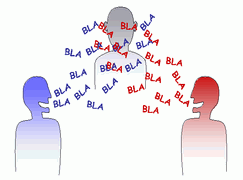Bach hearing aids’ localization improves speech understanding in noise
Localization improves speech understanding. Spatial awareness, or localization of sound, is important in quiet environments but is even more critical when it comes to understanding speech in noisy environments. Traditional hearing aid directional microphones are supposed to help people hear better in noise, however, they can also cause harm to understand speech harm by removing certain localization cues.
Localization helps the listener to know where a speaker is situated, which is essential to being able to hear and follow conversations, especially in noise, a situation where even individuals with normal hearing struggle to localize sounds.
Bach's better hearing technology
Bach utilizes new technology that addresses localization issues in noise for those who wear hearing instruments. Bach hearing aids’ localization improves speech understanding, even in noisy environments.
Dynamic Spatial Awareness is a key component of Speech Target Pro, a combination of three technologies that work together to determine the location of speech and help wearers hear their best in noisy conversations.
A recent field trial study results clearly demonstrated how Dynamic Spatial Awareness improves localization abilities in difficult listening situations, and how those improvements increase after acclimatization.
Localization improves understanding in noise
Localization is key for understanding conversations in noisy environments. With normal hearing and a properly functioning auditory pathway, localization can be performed quite well, until the signal-to-noise ratio (SNR) becomes negative.
This is partially due to the fact that the ability to locate a target talker becomes compromised in noise, which makes it more challenging to ignore other sounds and focus on the target speech.
This lack of localization makes it difficult to hear and understand the words being spoken, something hearing care professionals refer to as the “cocktail party problem.” In addition, while left/right judgments are slightly influenced by noise, front/back confusion is very strongly influenced by increased noise levels.
And then add hearing loss
Hearing loss can make matters even worse. When hearing aid wearers complain that sounds feel “jumbled” inside their heads, or that they have difficulty understanding who is speaking, they may not immediately realize these are issues associated with localizing sounds.
What an individual is really experiencing in this situation is a lack of spatial separation.
Our brains are able to gain acoustical advantages provided by spatial separation of speech from competing noises. When faced with multiple talkers, spatial differences enable our brains to sort out the acoustic mixture into distinct sources so we can focus our attention on a single source.
Hearing aids can sometimes interfere with spatial separation in noise, which is what causes the sounds to be “jumbled” and makes it difficult to focus on the speaker and understand what they are saying.
Solving the “cocktail party problem”
Even with normal-hearing individuals, knowing where the target talker is located significantly improves their ability to understand speech in noise. Being able to focus attention on a specific talker along the spatial dimension can play a very significant role in solving the “cocktail party problem”.

Bach’s Speech Target Pro was engineered to help wearers experience the best conversations in crowds and noise. Three advanced technologies in Speech Target Pro – Speech Locator, Speech Focus, and Dynamic Spatial Awareness, enable it to not only zone in on speech from any direction, but also provide beneficial localization cues to enhance speech and improve a wearer’s ability to hear in noise, beyond traditional directional microphones.
Speech Locator finds speech
In noisy situations, Speech Locator uses a combination of techniques and sound features to pinpoint where speech is coming from. It relies on multi-microphone detectors and beamforming techniques to locate different sound sources. Acoustic features are extracted from the input sound to determine if it contains speech.
Level detectors and SNR detectors add the final touch to binaurally determine the location of the speech. While Bach’s previous platforms included some of this technology, Speech Locator is a significant upgrade. In fact, it’s 50% more accurate and 36% faster at locating speech than previous technologies.
This combination of speed and accuracy is critical, much like driving a car, getting somewhere fast is meaningless unless you are navigating to the correct destination.
Speech Focus zones in on speech
Once the speech is located, Speech Focus comes into play. This third-generation dynamic speech perception and targeting technology helps the listener zone in on a speaker of interest in the midst of other speech and background noise. It does this using a variety of strategies.
When speech comes from the front, Speech Focus uses the maximum setting of its multiband adaptive directional system to focus on the speech and cancel noise sources from the sides and back.
When speech comes from the side, it uses a binaurally coordinated asymmetric response. If a speaker is to the left, Speech Focus zones in on the speech sound on the left, and cancels noise from the back and right.
When speech comes from the back, Speech Focus uses a beam that focuses to the back, but maintains some audibility to the front, ensuring that the listener has an adequate awareness of surroundings. In this situation, sounds from the front are reduced by approximately 10 dB, relative to the target speech at the back.
Since the accuracy and speed of Speech Locator are so robust and reliable, Speech Focus is able to be more aggressive at zoning in on speech – even in the Auto Sound Control 3 automatic program.
Dynamic Spatial Awareness makes speech stand out
Dynamic Spatial Awareness is the third component of the trinity of features behind the power of Speech Target Pro. Speech Locator and Speech Focus do a great job of identifying, locating, and zoning in on speech sounds. However, strong directional responses tend to destroy localization cues.
Dynamic Spatial Awareness modifies the directional responses of Speech Focus, depending on the direction of the target speech, to restore natural localization cues.
Testing was done to ensure that the frequency response change was aggressive enough to enhance the ability to localize the sound source. However, it couldn’t be so drastic as to prevent subjects from locating either other sounds in the environment around them or the speech source, if the direction of speech changed quickly.
Bach's 1-2-3 punch
People who wear hearing aids spend almost two-thirds of each day in conversation. Their ability to localize sound plays a large role in understanding speech in those conversations, especially in noisy environments. In order to address this problem, Bach hearing aids utilize Dynamic Spatial Awareness, a key technology within Speech Target Pro. Together with Speech Locator and Speech Focus, Dynamic Spatial Awareness helps wearers locate and understand speech in noisy conversations quickly and naturally.

